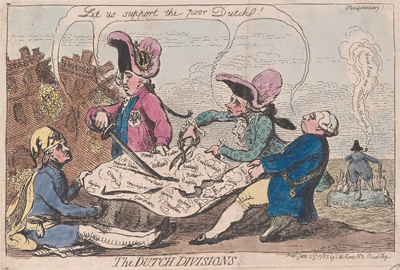The Dutch Divisions
This is a satire upon the hypocrisy of international power politics and the stupidity of William V, Stadholder of the Netherlands. It shows (from left to right) the seated Frederick William of Prussia with a dagger, the Emperor Joseph of Austria standing with a sword, Louis XVI of France with a pair of shears, and George III pulling with his hands. And on the far right, with the other silly geese, the isolated and inattentive William V, Stadtholder of the Netherlands.

© Beinecke Rare Book and Manuscript Library, Yale University
Most of the figures are portrayed using national streotypes that help to identify them. Frederick William, for instance, wears the hat of the Prussian Death's Head Hussars which had been adopted as their military emblem since Frederick the Great. The Austrian Emperor Joseph wears the double-eagle insignia of the Holy Roman Empire on his breast. His emperor's crown can be seen within his bicorne hat. The French King Louis is, of course, portrayed (like all of Gillray's Frenchmen) as thin and foppish. And his shears are more suggestive of a fashionable tailor than a French monarch. George III would, of course, have been recognizable to Gillray's audience without further symbols. And the Dutch Stadholder is portrayed as most Dutchmen, smoking a clay pipe and wearing a characteristic steeple hat. The four central figures all have tears in their eyes and profess concern for the Netherlands ("Let us support the poor Dutch!") But all of them are carving out parts of the Dutch empire for themselves on a map held before them. Meanwhile, the Dutch "Stadt House" with all its wealth is collapsing and splitting in two, and the leader of this pathetic nation seems content if he can be the "Absolute Monarch" of a single piece of it, the Dutch Island of Texel. The "dutch divisions" are, then, twofold: both internal and external.
As Simon Schama describes in Patriots and Liberators, by summer 1787, the Dutch were firmly split into two opposing camps: the Patriots who wished for more democratic representation in the States General, and the Orangist who supported the repressive Stadtholder and wished to preserve the current aristocratic monopoly on power. Of the seven provinces that made up the United Provinces of the Netherlands, "Three provinces adhered to the Patriots, two to the Stadtholder, with two disputed." (120) Each side had qualified support from one or more of their surrounding neighbors. France was largely funding the Patriots, England, the Stadtholder. For Austria, their holdings in the Austrian Netherlands were simply a pawn to be exchanged for control of Bavaria. And Prussia had a family connection (later exploited) in the person of the Stadtholder's wife Wilhelmina, who was Frederick William's sister. But each had his own agenda, and as Gillray makes clear, none of them cared a whit for the Dutch people.
Sources and Reading
- Commentary from the British Museum on The Dutch Divisions.
- "Frederick William II of Prussia," Wikipedia
- "Joseph II, Holy Roman Emperor," Wikipedia
- "George III of the United Kingdom," Wikipedia
- "Louis XVI of France," Wikipedia
- "William V, Prince of Orange," Wikipedia
- "Batavian Revolution," Wikipedia
- Simon Schama, Patriots and Liberators: Revolution in the Netherlands 1780 - 1813, London, 1992
Comments & Corrections
NOTE: Comments and/or corrections are always appreciated. To make that easier, I have included a form below that you can use. I promise never to share any of the info provided without your express permission.